
Rowan is a tree native to the cool temperate regions of the Northern Hemisphere. In European folklore, it has long been associated with the Otherworld, witches, and magic. Although the tree was once highly prized in Britain for culinary, medicinal, and magical uses, it has mostly fallen out of use in modern times.
Let’s learn about the wonders of the Rowan tree and return its many uses into our lives to boost our immune systems and magical powers!
Rowan’s name derives from the German verb “to redden” due to the color of its berries. But it is known most commonly as Mountain Ash because its leaves resemble those of Ash. However, Rowans are part of the family Rosaceae, and the same as roses, and its fruit appear similar to small rose hips.
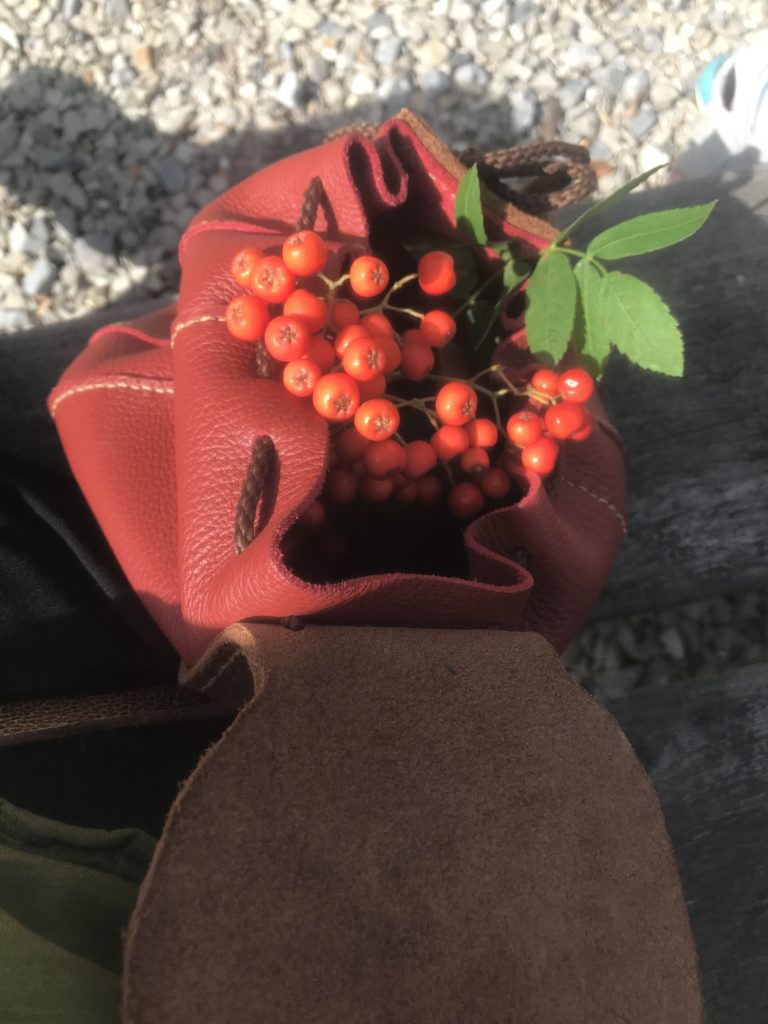
Rowan Tree Lore
Rowans also bear the name Witch Tree, which illustrates its long association with the magical arts. Rowans have often been used to depict the Tree of Life. They have also been used as a protector against evil influences and to conduct or direct spiritual energy.
Rowan’s association with magic and witches probably comes from the tiny five-pointed star or pentagram that adorns the bottom of each berry opposite its stalk. The pentagram is an ancient protective symbol, and so the fact that it naturally occurs on the berry marks it as magical. People have used the plant for protection and to induce second sight.
Norse Rowan Myths
In Norse mythology, the first woman was created from a Rowan tree. The tree is also strongly associated with Thor. The stories of Scandinavia tell us that the branch of a Rowan tree once saved Thor’s life when he was being quickly swept away by a fast-flowing river. From this myth, some mythologists believe that the Rowan tree in the story is actually a metaphor for Thor’s wife, the goddess Sif. Rowan was the wood of choice to carve rune staves, or sigils purported to have magical properties.
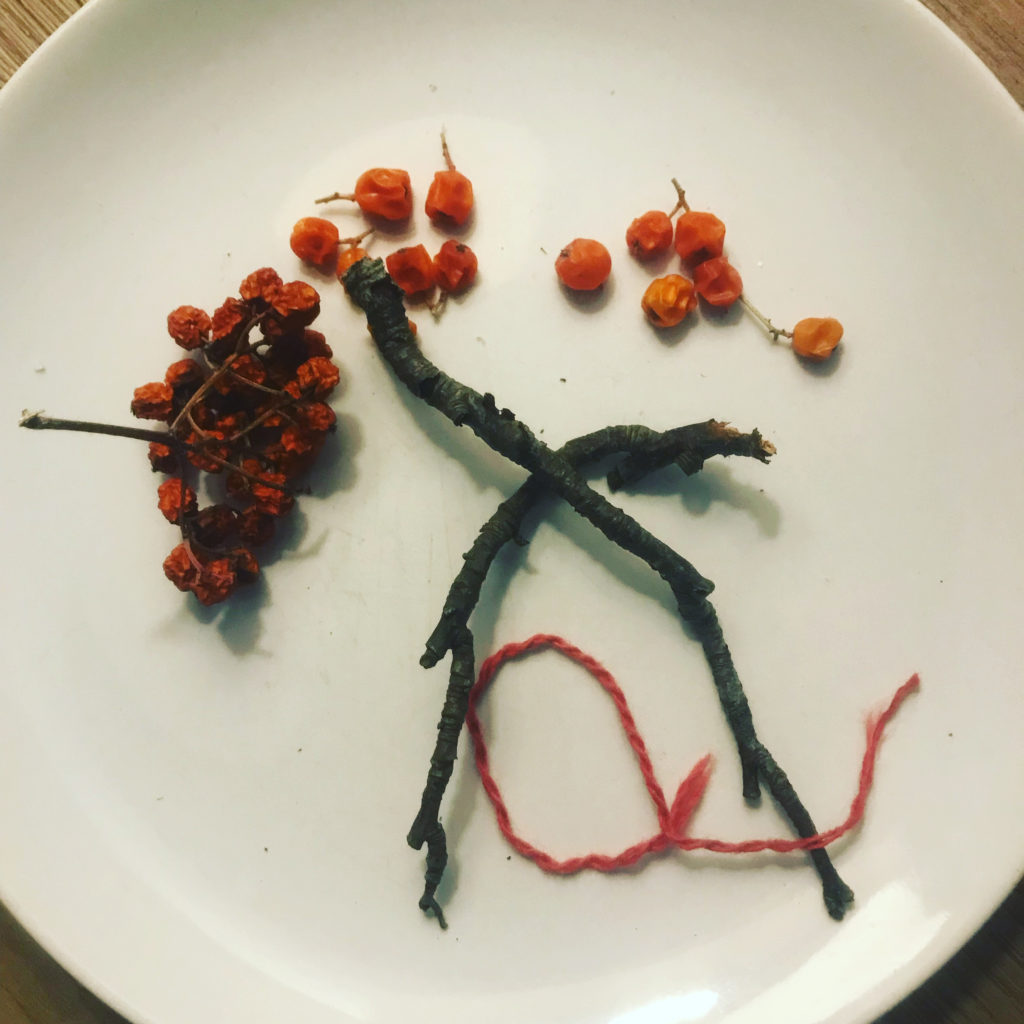
Meanwhile, in Britain, Scotland, and Ireland…
In the British Isles, especially in Scotland, Rowan is known as the Witch Tree. Protective amulets have long been made there from the wood and berries, bound with red thread, and hung in the home or barn.
There were once numerous taboos against cutting down a Rowan tree, cutting its branches with a knife, or using any parts of the tree, besides the berries without taking precautions specific to the purpose of using the wood, and how the tree was harvested.
In the past, it was common to plant Rowans near a house because people believed that lightning never struck the trees, and of course, Rowans were known to keep away witches. In Wales, they were planted in cemeteries to keep the spirits of the dead in check. Therefore, Rowan has a long association with the dead and our Ancestors. The time of year probably factors into this because its bright red berries ripen around the thinning of the veil times from late September to early November, depending on location.
After the conversion from the Old Religion, and during the times of Christianity, Rowan’s positive association with magic transformed to match Christian ideology. Since the emergence of Christianity as the dominant religion people started to believe that the berries with their pentagram and bright red color could protect people from witches and other harmful entities.

My Own Rowan Lore
I like to take my time to get to know new plants. So I took this past year to get to know Rowan. Rowan ties in very well with my personal ancestral practices. I have been working intensely with my various ancestral lineages over the past two years, and it has come to me that Rowan is associated with my biological maternal line.
This is an old Scottish lineage that originated before Scotland in what was once known as Hen Ogledd or, The Old North. My ancestors (actually on several lines, not just my maternal) were specifically part of what was once known as Goddodin, and The Kingdom of Strathclyde, maybe even the fabled Aeron. Its inhabitants were Celtic Britons, who once spoke a now-dead language called Cumbric, which is close to modern-day Welsh, Cornish, and Breton.
The region was strongly associated with the people of Wales. They were self-perceived as a single people, collectively referred to in modern Welsh as Cymry. Thereby, the language and cosmology are strikingly Welsh instead of Gaelic as one might assume from the location. However, Strathclyde was eventually incorporated into the Gaelic speaking Kingdom of Scotland in the 11th century.
During mystical meditation, my Brittonic grandmothers showed me a bunch of red berries protruding from a stem of long lance-shaped leaves with a saw-like edge. I thought they were showing me, Elder, for the longest time, but while I was working with this particular lineage, I discovered three beautiful Rowan trees growing in the green space behind my apartment in Brussels. I recognized the magically charged plant they meant for me.
We often have these kinds of experiences when we are in deep work with the Other Realms. We see signs and signals to help us understand the downloads of information we receive, which are not always apparent and easy to understand. These signs given in the mundane world help verify and solidify the messages we are receiving.
In this vision, they showed me how they used this berry in the ritual where they received “Bear Dreams” from hibernating bears. They tapped into the bears’ dreams, and through these dreams, they were able to interpret messages and omens to help their community. Bears have long been associated with Otherworldly knowledge and the Other Realms because they reside in liminal space for several months every year during hibernation.
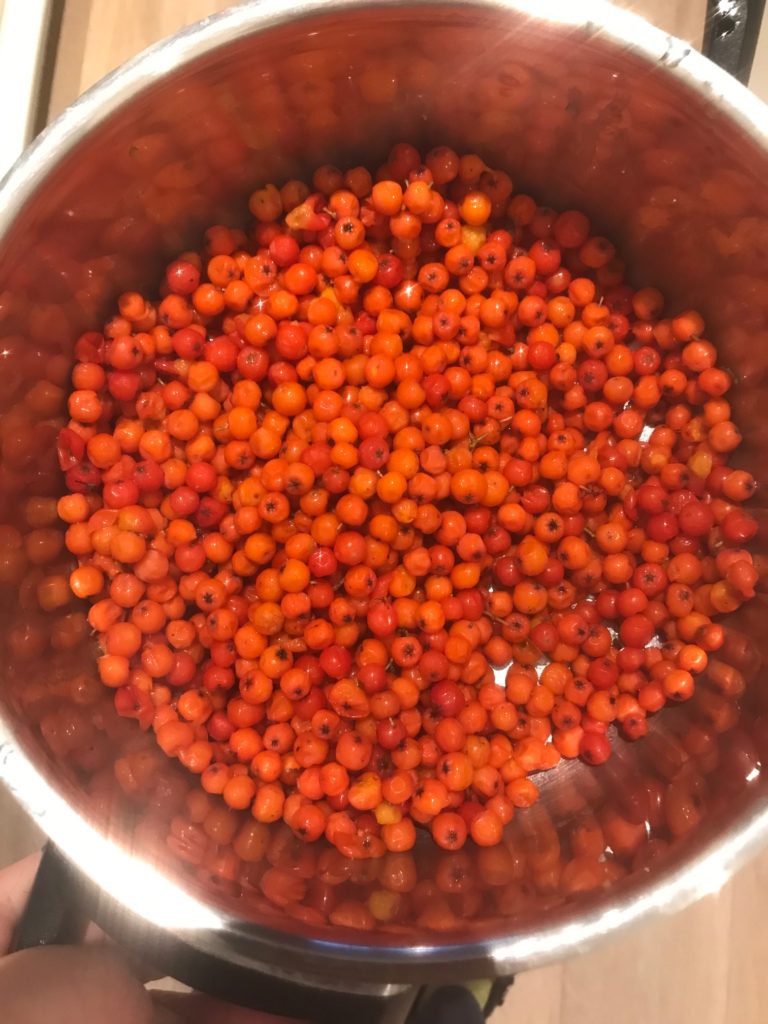
What Do Rowan Berries Taste Like?
Rowan berries taste a bit like tarter or unripe cranberry. They are also similar to other small wild berries like lingonberries, hawthorn, sloes, and currants. The traditional uses are best in savory applications or to flavor beverages.
Similar to the medlar, Rowan berries generally taste better after the first frost has bitten them. But most people prefer to cook them in some way to sweeten their naturally astringent taste.
If eaten raw, you could wind up with an agitated stomach. The raw fruits contain slightly toxic acids. So I suggest cooking with them, as it is the most effective way to render them edible.
Health Benefits of Rowan
Don’t let that intimidate you from using the fruits. Rowan berries are richer in vitamin C than even lemons, therefore great as an immune booster during the winter months. Rowan berries also contain anthocyanins, tannins, polyphenolic compounds, and flavanols, including various quercetin and rutin types.
The berries also provide vitamins A, carotin, and are a natural pectin. For all of these benefits, Rowanberries are known in folk medicine as anti-oxidants and anti-inflammatories.
How to Identify Rowan
Rowan berries are commonly red, but can also come in bright orange colors. Of course, there is also a pentagram at their base. The leaves are long and lance-shaped.
You don’t need to harvest a lot of Rowan for it to make a significant impact on your culinary delights, health, or magical abilities. The key is, a little goes a long way in all respects. Be sure to save some of the berries for the birds who use the berries as a food source.
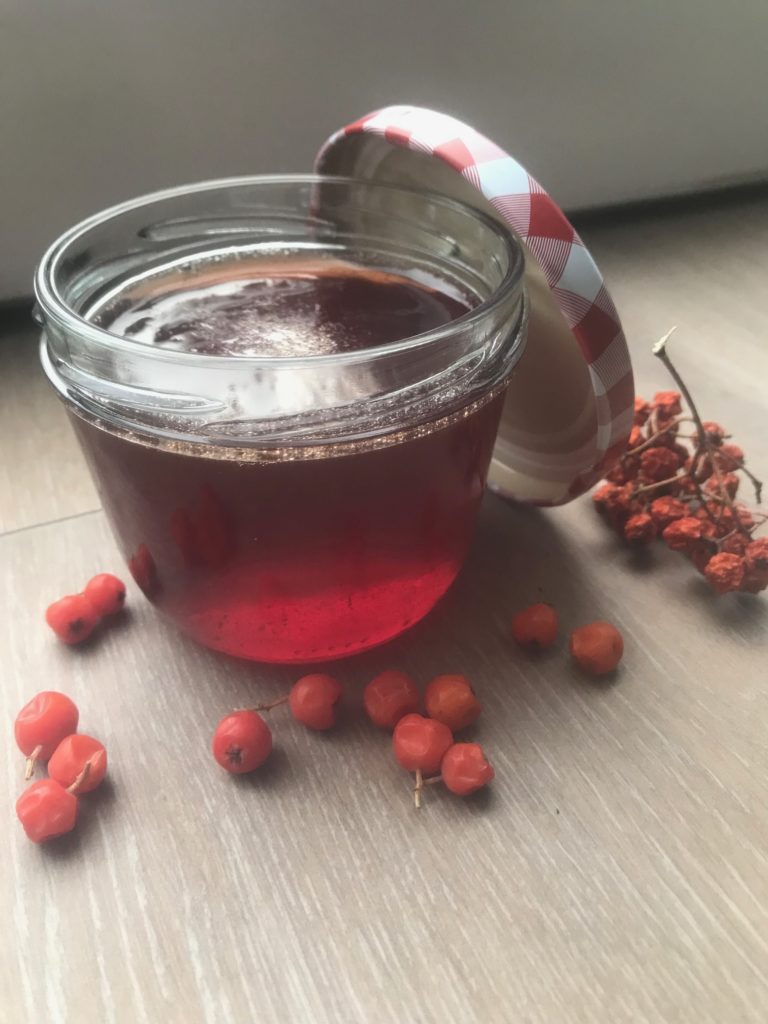
Culinary Uses for Rowan
I find that a hands-on project is a lovely way to understand the inner workings of a plant. To further familiarize myself with Rowan, I decided to cook with her. Cooking is my love language, and ultimately the most intimate way for me to work with a plant.
I learned that peoples indigenous the Americas, like the Algonquin, Quebec, Montagnais, and Ojibwe, use the dried and ground berries to add a pleasantly sour taste to soups and stews. Rowan berries also have many traditional uses in alcoholic beverages, mainly to flavor liqueurs, wines, ales, and cordials.
I started with something simple, like adding her berries to some slow-cooked stews with mushrooms and forest herbs. I also traditionally prepared her berries by making preserves (recipe below).
How To Use Rowan Berry Preserves
Rowanberry preserve is delicious with aged cheeses. I especially love it served with sharp cheddar cheese and oatcakes.
You can also use the preserves as a base for sauces. A sauce with a rowan berry base is delicious, especially with pork. It lends a flavor similar to pairing pork with sour cherries. The preserves would also work well in a savory cheese tart with caramelized onions.
Rowan Berry Preserves Recipe
I based this recipe off of the one posted by Cailleach’s Herbarium, which is based on the recipe by F. Marian McNeill in her book the “Scots Kitchen (its lore and recipes)” (1929, Glasgow)
INGREDIENTS:
Three parts rowan berries (washed and stems removed) to 2 parts apples (peeled, cored, and quartered)
Sugar (1 pound white sugar for every 2 cups of juice produced)
water (filtered)
*you do not need pectin, Rowan is a natural pectin.
METHOD:
Place the fruit in a non-reactive large pan or stockpot, making sure there is enough room to allow the mixture to come to a rolling boil without spilling over.
Then just cover the fruit with cold, clean water, the best quality you can get.
Over medium heat, bring the fruit and water mixture to a boil.
Reduce the heat to low and simmer for about 40 minutes, or until the fruit is soft.
Let the mixture cool off for about 15 minutes.
Place a strainer over a bowl and let the mixture strain for at least 12 hours. Make sure not to push on the fruit pulp to extract more juice.
Once the juice has accumulated in the bowl, measure it. Then measure out your sugar (1 pound of sugar for every 2 cups of juice produced).
Add the juice and sugar to a clean non-reactive large pan or stockpot and simmer over low heat for about 10 minutes until the sugar has dissolved.
Increase the heat until it boils. Cook at a full rolling boil for another 10 minutes or so, then check for a set following a setting-point test. Here are some ways to test.
Once the jelly has reached the setting point, pour into hot, sterilized jars, seal and label.
Related Posts:
Sardinia’s Ancient Olive Trees
Thresholds to the Otherworld: Thorn & Hedge Magic
Ancestral, Earth, and Viral Wisdom
“The Golden Apples of Asgard”: Ricotta Stuffed Nectarines
Late Autumn Old World Fruits: Quince (part 1)





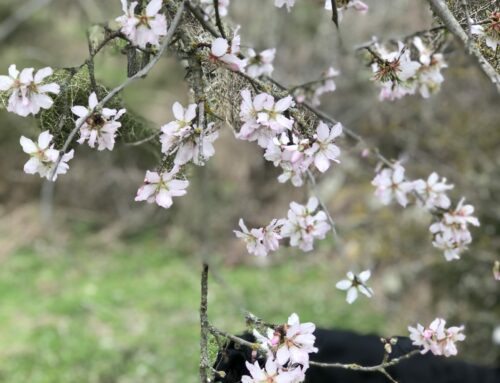


thankyou, beautiful and insightful. the part about the bear wisdom was very profound for me; i feel a deep connection to the magic of rowan and the bear as spirit animal. ?
Hi Karina, Thank you so much for your comment. I am so happy that it resonated with you.
This autumn, the magic of Rowan is beckoning. I just picked a few berry branches today asking the tree spirit to teach me the sacred magic it offers. I so deeply resonate with bear wisdom. Thank you for sharing. May I ask how it maybe used for bear dreaming ritual?